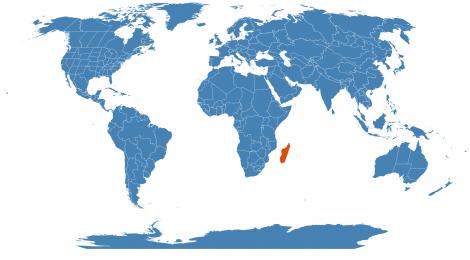Accession Data:
Euphorbia didiereoides Denis ex Leandri
subg. Euphorbia sect. Goniostema
- Common Name:
- Family: Euphorbiaceae Juss.
- Country of Origin: Madagascar: Zazafotsy/Zomandao area

- Habitat: on rock outcrops scattered in grassland, in the high plateau area
- Uses: A leaf decoction is taken to treat coughs in children, urogenital infections, haematuria and prostatic hypertrophy.3
Accession Data:
- Accession # 201300044
- Source: Rob Nicholson - Smith College
- Provenance: Smith# 113-13 ex NYBG# 413/84 (cutting)
- Accession Date: 10-08-2013
- Bench: 2201 - XER:Madagascar Spiny Thicket A
- Currently: active - healthy
- Qty: 1 confirmed on 04-14-2025
- Restrictions:
- IUCN Red List: Endangered Species
- IUCN Red List: Endangered Species
Classification:
- Division: Magnoliophyta
- Class: Magnoliopsida
- SubClass: eurosid I
- Order: Malpighiales
- SubOrder:
- Family: Euphorbiaceae
- SubFamily: Euphorbioideae
- Tribe: Euphorbieae
- SubTribe: Euphorbiinae
Flowering Data:
This accession has been observed in bloom on:| Year | Jan | Feb | Mar | Apr | May | Jun | Jul | Aug | Sep | Oct | Nov | Dec | ||||||||||||||||||||||||||||||||||||||||
|---|---|---|---|---|---|---|---|---|---|---|---|---|---|---|---|---|---|---|---|---|---|---|---|---|---|---|---|---|---|---|---|---|---|---|---|---|---|---|---|---|---|---|---|---|---|---|---|---|---|---|---|---|
| 2025 | ||||||||||||||||||||||||||||||||||||||||||||||||||||
| 2024 | ||||||||||||||||||||||||||||||||||||||||||||||||||||
| 2023 | ||||||||||||||||||||||||||||||||||||||||||||||||||||
| 2022 | ||||||||||||||||||||||||||||||||||||||||||||||||||||
| 2021 | ||||||||||||||||||||||||||||||||||||||||||||||||||||
| 2020 | ||||||||||||||||||||||||||||||||||||||||||||||||||||
| 2019 | ||||||||||||||||||||||||||||||||||||||||||||||||||||
| 2018 | ||||||||||||||||||||||||||||||||||||||||||||||||||||
| 2017 | ||||||||||||||||||||||||||||||||||||||||||||||||||||
| 2016 | ||||||||||||||||||||||||||||||||||||||||||||||||||||
| 2015 | ||||||||||||||||||||||||||||||||||||||||||||||||||||
| 2014 | ||||||||||||||||||||||||||||||||||||||||||||||||||||
| 2013 | ||||||||||||||||||||||||||||||||||||||||||||||||||||
References (internal):
- EEB Greenhouse Holdings native to: Madagascar
References (external):
- The Plant List (2010). Version 1. Published on the Internet; http://www.theplantlist.org/ (accessed 08 October 2013).
- Haevermans, T. 2004. Euphorbia didiereoides. In: IUCN 2013. IUCN Red List of Threatened Species. Version 2013.1. Downloaded on 08 October 2013.
- Plant Resources of Tropical Africa
- Euphorbia didiereoides in Euphorbia Planetary Biodiversity Inventory. Accessed 13 August 2015.
data regenerated on Wed, 02 Jul 2025 15:54:14 -0400 [bcm v4.0]
Images:

Additional images for this accession:
Click on thumbnails to enlargeCurrent Accessions in the Euphorbiaceae
Subfamily Acalyphoideae
Tribe Acalypheae
- Acalyphinae: Acalypha chamaedrifolia



- Acalyphinae: Acalypha hispida



- Acalyphinae: Acalypha wilkesiana `Macafeana'


- Ricininae: Ricinus communis


Subfamily Acalyphoideae
Tribe Plukenetieae
- Dalechampiinae: Dalechampia spathulata



Subfamily Crotonoideae
Tribe Aleuritideae
- Aleuritinae: Aleurites moluccanus

- Garciinae: Garcia nutans

Subfamily Crotonoideae
Tribe Codiaeae
Subfamily Crotonoideae
Tribe Crotoneae
Subfamily Crotonoideae
Tribe Jatropheae
Subfamily Crotonoideae
Tribe Manihoteae
Subfamily Crotonoideae
Tribe Micrandreae
- Heveinae: Hevea brasiliensis

Subfamily Euphorbioideae
Tribe Euphorbieae
- Euphorbiinae: Euphorbia abyssinica

- Euphorbiinae: Euphorbia aeruginosa

- Euphorbiinae: Euphorbia alluaudii ssp. oncoclada

- Euphorbiinae: Euphorbia antiquorum

- Euphorbiinae: Euphorbia antisyphilitica

- Euphorbiinae: Euphorbia baioensis

- Euphorbiinae: Euphorbia beharensis var. guillemetii

- Euphorbiinae: Euphorbia bicompacta

- Euphorbiinae: Euphorbia bicompacta var. rubra

- Euphorbiinae: Euphorbia bupleurifolia

- Euphorbiinae: Euphorbia bupleurifolia x susannae
- Euphorbiinae: Euphorbia caerulescens

- Euphorbiinae: Euphorbia canariensis

- Euphorbiinae: Euphorbia caput-medusae

- Euphorbiinae: Euphorbia clandestina
- Euphorbiinae: Euphorbia croizatii

- Euphorbiinae: Euphorbia cylindrifolia

- Euphorbiinae: Euphorbia decaryi


- Euphorbiinae: Euphorbia didiereoides


- Euphorbiinae: Euphorbia enterophora

- Euphorbiinae: Euphorbia francoisii


- Euphorbiinae: Euphorbia globosa W/C

- Euphorbiinae: Euphorbia greenwayi var. greenwayi


- Euphorbiinae: Euphorbia guiengola



- Euphorbiinae: Euphorbia knuthii

- Euphorbiinae: Euphorbia lactea

- Euphorbiinae: Euphorbia leuconeura



- Euphorbiinae: Euphorbia lomelii
- Euphorbiinae: Euphorbia magnifica

- Euphorbiinae: Euphorbia mammillaris


- Euphorbiinae: Euphorbia mauritanica

- Euphorbiinae: Euphorbia milii var. splendens

- Euphorbiinae: Euphorbia neriifolia

- Euphorbiinae: Euphorbia obesa

- Euphorbiinae: Euphorbia obesa ssp. obesa


- Euphorbiinae: Euphorbia platyclada

- Euphorbiinae: Euphorbia polygona cv. 'Snowflake'
- Euphorbiinae: Euphorbia pseudoglobosa

- Euphorbiinae: Euphorbia resinifera

- Euphorbiinae: Euphorbia ritchiei subsp. ritchiei

- Euphorbiinae: Euphorbia stenoclada

- Euphorbiinae: Euphorbia susannae

- Euphorbiinae: Euphorbia tetracanthoides

- Euphorbiinae: Euphorbia tirucalli

- Euphorbiinae: Euphorbia trigona

- Euphorbiinae: Euphorbia virosa ssp. virosa

 = indicates flowering in past 14 days
= indicates flowering in past 14 days
 = images available for this accession
= images available for this accession
 = map available for this accession
= map available for this accession
 = accession added within past 90 days
= accession added within past 90 days

